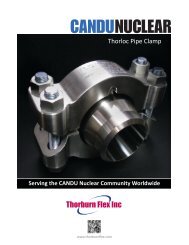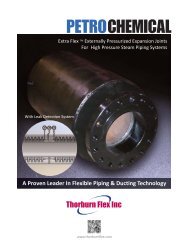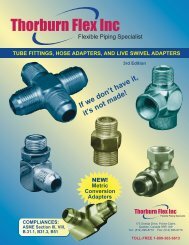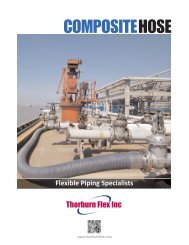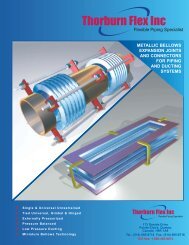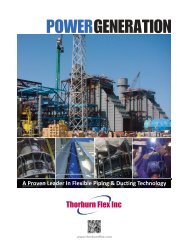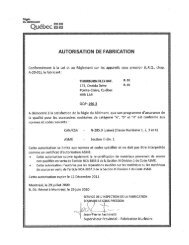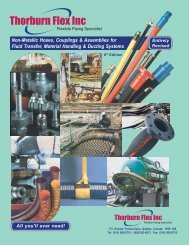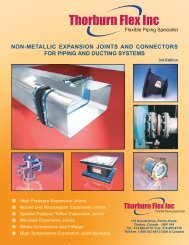Hydraulic Hose Assemblies - Thorburn Flex Inc
Hydraulic Hose Assemblies - Thorburn Flex Inc
Hydraulic Hose Assemblies - Thorburn Flex Inc
Create successful ePaper yourself
Turn your PDF publications into a flip-book with our unique Google optimized e-Paper software.
Technical Data<strong>Hose</strong> Routing and InstallationUnder pressure, a hose’s length maychange. Always provide some slack inthe hose to allow for shortening or elongation.However, excessive slack in hoselines may cause poor appearance.When hose lines pass near an exhaustmanifold or other heat source, they shouldbe insulated by a heat resistant boot,firesleeve or a metal baffle. In any application,brackets and clamps keep hoses inplace and reduce abrasion. For installationswhere abrasion to the hose cover cannotbe prevented by using clamps or brackets,a steel protective coil or abrasion resistantsleeve should be placed over the hose.At bends, provide sufficient hose to avoida bend radius less than the hose’s recommendedminimum bend radius. Too tight abend may kink the hose and restrict orsnap the fluid flow. In most cases, theproper use of adapters and hose fittingscan eliminate tight bends or kinks.90°When 90° adapters are used, this assemblybecomes neater looking, easier toinspect and maintain, and uses less hose.1”MinimumBend RadiusIf a hose is installed with a twist in it,operating pressures tend to force it tostraighten. This can loosen the fittingnut. Twisting can cause reinforcementseparation and the hose could burst atthe point of strain.In applications where there is considerablevibration or flexing, allow additionalhose length. The metal hose fittings, naturally,are not flexible, and proper installationprotects metal parts from unduestress, and avoids kinks in the hose.Cleaning, Inspection, Testing and Storage of <strong>Hose</strong> <strong>Assemblies</strong>Maintenance<strong>Hose</strong> assemblies in operation should beinspected frequently for leakage, kinking,abrasion, corrosion or any othersigns of wear or damage. Worn or damagedhose assemblies should bereplaced immediately.CleanClean assembly byblowing out with cleancompressed air.<strong>Assemblies</strong> may berinsed out with mineralspirits if the tube stock is compatible withoil. Otherwise hot water at 150°F. maximummay be used. Consult <strong>Thorburn</strong> forspecial cleaning equipment.InspectExamine hose assemblyinternally with a boroscopeor flashlight for cutor bulged tube, obstructions,and cleanliness.Check for proper gapbetween nut and socket or hex and socket.Nuts should swivel freely. Check thelayline of the hose to be sure that theassembly is not twisted. Cap the ends ofthe hose with plastic covers to keep clean.Proof test (hydrostatic)The hose assembly should be hydrostaticallytested at twice the recommendedworking pressure of the hose.Test pressure should be held for notmore than one minute and not less than30 seconds. When test pressure isreached, visually inspect hose assemblyfor: any leaks or signs of weakness; anymovement of the hose fitting in relationto the hose. Any of these defects arecause for rejection.Caution: testingshould be conductedinapproved teststands with adequateguards toprotect theoperator.6Proof test (pneumatic)<strong>Hose</strong> assembliesintended fo gas or airservice should be testedwith air or nitrogenat 100 psi with theassembly immersed inwater. Random bubblesmay appear over the hose and fittingarea when assembly is first pressurized.This should not be construed as adefect. However, if the bubbles persist informing at a steady rate at any particularpoint on the hose, the assembly shouldbe rejected.Caution: testing should be conducted inapproved test stands with adequateguards to protect the operator.Storage and handling<strong>Hose</strong> should be stored in a dark, dryatmosphere away from electrical equipment,and the temperature should notexceed 90°F. Storage in the original shippingcontainer is preferred.




